UPPER BLEPHAROPLASTY & PTOSIS REPAIR: COMMONLY ASKED QUESTIONS

UPPER BLEPHAROPLASTY & PTOSIS REPAIR: COMMONLY ASKED QUESTIONS
“Droopy upper eyelids” are caused by excess skin and fat (dermatochalasis-which is repaired with a blepharoplasty) and/or weakness of the levator muscle (ptosis-which needs a ptosis repair). When either or both of these conditions interfere with peripheral vision, lifting of the upper eyelids may be performed. Whether the procedures are covered or not depends upon the decision that your insurance company makes. The procedures (blepharoplasty and ptosis repair), when approved, are performed to improve the field of vision, not for cosmetic reasons. Also, the surgery does not improve central vision, only the peripheral vision fields.
FAQS
Aspirin, aspirin-containing drugs, ibuprofen and other blood-thinners should be stopped 7 days before surgery. This includes herbs, all vitamins, and certain other drugs: we will give you a list which covers most such thinners. If you are on prescription blood-thinners like Coumadin or Plavix, we will advise you and your physician about possible changes in that medication prior to and after surgery.
There will be blurry vision during the healing phase: this may last from a few weeks to, sometimes, more than two months. Most patients can function perfectly well but the refraction may change. Some patients need a refraction for new spectacles about two months (or more) after surgery.
Our upper eyelids are never the same height: before or after surgery. Some degree of asymmetry will be present before and after surgery. This is normal.
When upper eyelids are lifted, everyone will experience some degree of dryness and light-sensitivity. When patients have pre-existing dry eyes, we will perform a conservative lift of the upper eyelids. This means that we leave some fullness and a little droop so that the patient can still open AND shut the eyelids. However, even with these precautions, everyone will need some increased lubrication of their eyes with over-the-counter artificial tear drops. The need for sunglasses is understandable, once the lids are more open.
There is no need for any incisions or stitching, as the treatment is carried out with a C02 fractional laser. The entire session is completed in under an hour.
Almost everyone develops some degree of brow droop (called brow ptosis). This can cause some heaviness on the outer part of the upper eyelids (called temporal hooding). Brow lifts can be performed to lift the brows, but they generally do not improve the field of vision (unless the patient has a paralysis of the face). Brow lifts are done when the patient decides they want a cosmetic improvement of the forehead wrinkles, frown lines and brow height and curve. This procedure does not improve vision and is not performed for functional reasons. It is important to remember that when a brow lift is not done, there will be some heaviness of the outer part of the upper eyelid and the smile-line area. This will not affect your vision, but you may be aware of it cosmetically. This temporal heaviness cannot be improved by extending the upper eyelid incisions as unacceptable scars will result. If you want a cosmetic improvement in this area (and the forehead, frown lines, brow positions, etc), please ask about the pros and cons of performing a brow lift. There are many different ways of performing a brow lift: the best approach is chosen for each patient, based upon multiple factors.
The upper eyelid sutures will dissolve between one and three weeks after surgery. As the sutures dissolve, little bumps will be felt on the incision sites for a few weeks: this is normal.
The upper eyelid margins (eyelashes, roots of the eyelashes, and the margin of the upper eyelids) will feel numb for a number of weeks: the sensation recovers over six to eight weeks, sometimes a little longer. Some patients, when they cannot normally feel their upper eyelid lashes, will think that their eyelashes have been cut: WE NEVER CUT EYELASHES! They are too valuable!
Everyone gets bruising and swelling! One side always bruises more than the other! Using ice on-and-off (20 minutes on and 20 minutes off works well) for the first two days helps reduce bruising and swelling more quickly. Sleeping with two or three pillows for the first couple of nights helps reduce swelling. You may use warm soaks on your eyelids after the first couple of days.
Surprisingly, most patients find they get very little discomfort after this surgery. You may need the prescription pain medication for one or two days; thereafter, simple over-the-counter pain medication like Tylenol suffices.
If your work involves heavy lifting or a lot of computer time, you would be wise to get a week off work. Depending upon your specific requirements, we will be happy to give you a note for work.
Surgery takes about an hour, but we do not rush anything. When you come for surgery, please do not make any other appointments for the day as the duration of surgery is not always predictable. Also, by the nature of Medicine, emergencies are seen almost daily and may delay more routine cases. Furthermore, it is not uncommon for the surgeon to take longer (or shorter) on some cases, depending upon findings: therefore, surgery times are ESTIMATES ONLY.
Performing upper eyelid surgery does NOT improve or worsen the appearance or position of the lower eyelids! Lower blepharoplasty (removal of fat bags, improving wrinkles, tightening loose skin, improving spots and bumps) does not improve your vision. Therefore, lower blepharoplasty is a cosmetic procedure which can be performed if the patient so desires. Please ask us any questions you may have about this or any other procedures.
Plastic surgery is more an art than a science. In about one in twenty patients, it may be necessary to make a small adjustment to remove or add sutures and change the height of one or the other eyelid. As lids settle over a number of months, such adjustments are only performed a few months after surgery: we will guide you as needed.
- You may wash/bathe the day after your surgery and even get your eyelids wet.
- Do not rub your eyelids vigorously for the first two weeks.
- Expect some oozing of blood for the first two to three days: this is normal.
- No swimming in a swimming pool for two weeks please.
- No vigorous exercise for one week (tennis, skiing, etc).
- Most patients can drive/walk/etc the day after surgery. Sometimes, swelling can make driving difficult for a couple of days.
- You will have trouble wearing contact lenses for about a week.
Absolutely not! This surgery is performed only to improve your fields of vision and therefore, you have the choice of having or not having this surgery: it is entirely your choice.
If your history indicates that your upper eyelids interfere with your vision, if your clinical examination shows a significant degree of droop of your upper eyelids, if your visual fields show a significant degree of superior visual field constriction, and if your clinical photographs show a significant “droop” of your upper eyelids, these findings are submitted to your insurance company for preauthorization. If your findings do not meet these requirements, we cannot submit the surgery to your insurance company. If you have Medicare, you will know that Medicare does NOT give preauthorization prior to surgery: you have to decide if the eyelids interfere with your vision sufficiently and we will guide you as to whether Medicare may or may not cover your surgery. This is only a guidance: the final decision would be made by Medicare. Please remember that we work for you and do everything possible to get your surgery covered by your insurance company when you meet the necessary requirements.
Preauthorization may take four to six weeks from the time of submission of your information to the insurance company: we don’t have control over this, unfortunately.
Please be sure to ask us any questions you may have whilst you are being seen in clinic so we can help you understand the procedures. Our team of Abraham, Mike, Diana, Patricia and others in clinic will be delighted to help you. You may also contact us:(801) 413-3599 (Salt Lake City) and (435) 215-0014 (St. George)
Thank you for coming to see us.
Sincerely,
Prof. BCK Patel MD, FRCS
PLEASE read the above information in detail, more than once if necessary! If you should have any other questions, please do not hesitate to ask. To book an appointment, please click here.
To download a PDF of this page, please click here.
Quick Enquiry
Short on time? Simply send your enquiry here and we will get back to you with more information.
www.englishsurgeon.com: Site of the "English Surgeon" website. Dr. BCK Patel MD, FRCS, Salt Lake City, St. George, Layton, Orem, Mid-Town, Utah; London, England
Originator of London Blepharoplasty, London Facelift, London Browlift, Patel Hammock Lift, SMURF Festoon Correction. Created by Patel Plastic Surgery - Dr. Bhupendra C. K. Patel MD, FRCS
Dr. BCK Patel MD, FRCS 1025E 3300S Salt Lake City, Utah 84106, USA (801) 413-3599 (phone/text) E: info@patelplasticsurgery.com
Dr. BCK Patel MD, FRCS 585 E Riverside Dr Suite 201 Saint George, UT 84790 (435) 215-0014 E: drbckpatel@gmail.com




